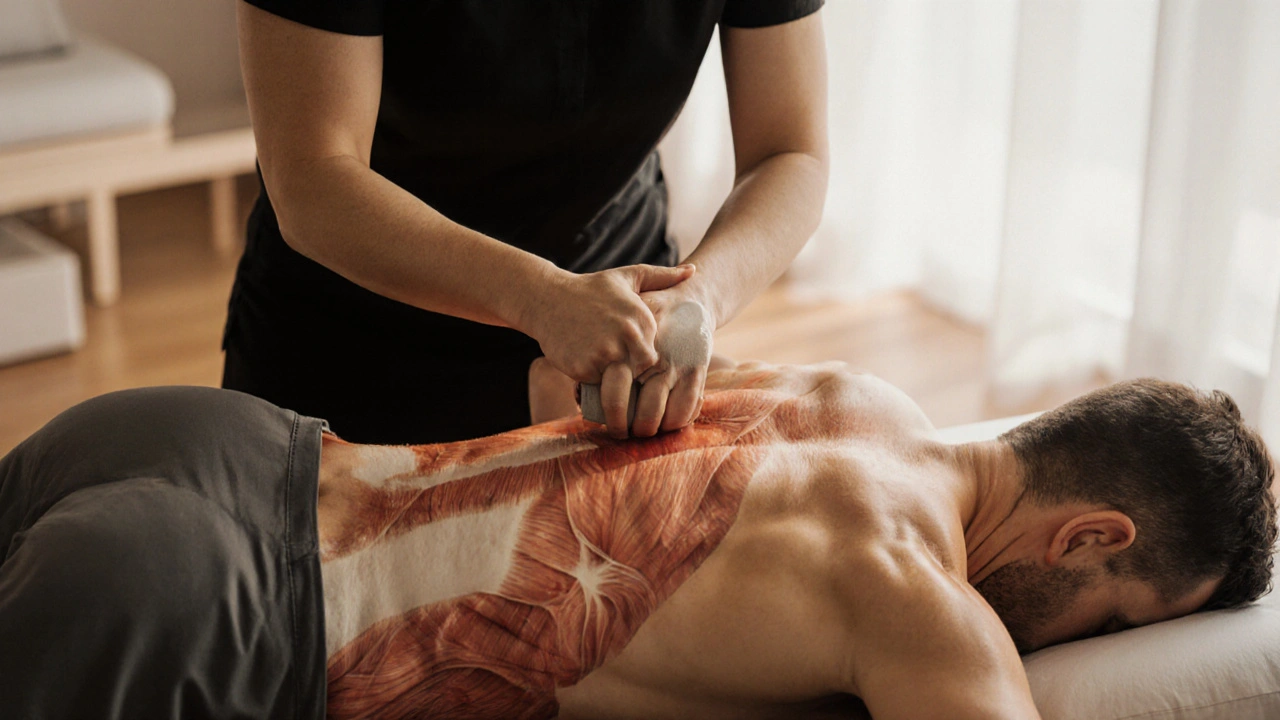Deep Tissue Massage: Revitalize Your Body and Mind

Ever finish a workout or a long workday and feel like your muscles are made of concrete? That’s where deep tissue massage steps in. Instead of just skimming the surface, this technique gets right into the knots and tension buried deep in your muscles. It’s a game changer for folks who’ve tried everything from stretching to foam rolling—yet still feel locked up or sore.
Here’s the thing: deep tissue massage isn’t just for athletes or fitness junkies. Desk job? Weekend warrior? Stressed out parent? Everyone picks up tension somewhere. This kind of massage can help with recovery, lower back pain, neck stiffness, or just that sluggish feeling that drags you down.
If you’re ready for real relief instead of a quick fix, you’re looking in the right place. This guide covers what deep tissue massage actually is, why people swear by it, and simple steps for finding the right therapist in your area—plus what happens during a session so you’re not left guessing.
- Key Takeaways
- Quick Facts
- What Is Deep Tissue Massage?
- Why Try Deep Tissue Massage?
- How to Find a Great Therapist
- What Happens During Your Session?
Key Takeaways
If you want the lowdown on deep tissue massage, here’s what really matters:
- Deep tissue massage focuses on the deeper layers of muscle and connective tissue, which means it’s great for stubborn tension and chronic aches.
- This isn’t your average spa day. A session can feel intense but works wonders for people with old injuries, nagging pain, or anyone recovering from tough workouts.
- It’s big on results: folks using deep tissue regularly often report less muscle soreness, better range of movement, and a real mental lift thanks to stress relief.
- Sessions normally last 60 to 90 minutes. Most therapists will ask about your pain points and goals before they start, so you get targeted results instead of a one-size-fits-all routine.
- Deep tissue massage isn’t just for the super active. Desk workers, busy parents, and anyone stuck in one position for hours can benefit.
- Always talk to your therapist about your medical history and comfort level. This helps avoid unnecessary pain or issues during your session.
| Benefit | Who Needs It | How Often? |
|---|---|---|
| Muscle Recovery | Athletes / Gym-goers | Bi-weekly to monthly |
| Pain Relief | People with chronic pain | Weekly at first, then as needed |
| Stress Reduction | Anyone with high stress | Monthly or more often |
Don’t forget: results can vary. After your first deep tissue massage, you may feel immediate relief, but deeper healing usually takes a few sessions. Consistency is key if you want long-term benefits.
Quick Facts
Here’s what you need to know fast about deep tissue massage before booking your first session:
- This technique uses slow, firm pressure to target deeper layers of muscle and connective tissue. Feel a stubborn knot? This helps release it.
- Deep tissue massage is popular for treating chronic pain, stiff necks, upper and lower back pain, and tight shoulders from desk jobs or exercise.
- Sessions usually last between 60 and 90 minutes. Most people notice relief after just one visit, but lasting results often show up after a series of treatments.
- You might feel a bit sore for a day or two after, kind of like post-workout soreness. That’s normal—it means your body is realigning and tension is moving out.
- This style isn’t about making you wince in pain. Good therapists check in with you and adjust pressure so you get relief, not regret.
| Average session time | 60–90 minutes |
|---|---|
| Most common issues treated | Chronic back/neck pain, muscle stiffness, sports injuries |
| Reported soreness after treatment | About 42% of clients |
| Recommended session frequency | Every 1–3 weeks |
As the Mayo Clinic puts it,
"Deep tissue massage is especially helpful for chronic aches and pains and contracted areas such as a stiff neck and upper back, low back pain, leg muscle tightness, and sore shoulders."
Remember, it’s always smart to talk to your therapist about what you want from your massage therapy session. That way, you get the most out of the experience and keep your wellness goals front and center.
What Is Deep Tissue Massage?
So, what exactly is deep tissue massage? It’s a hands-on technique where the therapist uses slow, firm pressure to reach the deeper layers of your muscles and connective tissues. Unlike a gentle spa massage, this one means business. Think of it as rebooting muscles that feel knotted, achy, or way too tight.
The goal? Break up scar tissue, reduce muscle tension, and help your body heal—especially if you deal with nagging pain or old injuries. Therapists use their thumbs, elbows, forearms, or even special tools to really get into those stubborn spots. You might feel some ‘good pain’ during the session—it shouldn’t feel sharp or unbearable, but you’ll definitely know something’s happening.
Here’s how deep tissue massage stands out:
- Targets chronic pain or tension, not just surface-level aches.
- Helps boost blood flow and speed up muscle recovery.
- Often recommended by doctors and PTs for issues like back pain, sports injuries, or whiplash.
- Techniques can include slow strokes, deep circular movements, or long, sustained pressure on problem areas.
Researchers have found some real benefits, too. One study in Journal of Clinical Psychiatry showed deep tissue treatments can lower blood pressure and reduce stress hormones after just one session. It’s not magic—just the science of touch working to loosen you up.
| Type of Massage | Pressure Level | Main Purpose |
|---|---|---|
| Deep Tissue | Firm to strong | Release tight muscles and chronic knots |
| Swedish Massage | Light to medium | Relaxation and basic tension relief |
If you walk in with super tense shoulders or a stiff lower back, don’t expect everything to melt away instantly. Sometimes, you’ll need a few sessions for long-term results. But if you want relief that sticks, deep tissue massage delivers results where you feel it most.

Why Try Deep Tissue Massage?
If you’ve ever had muscle pain that just won’t quit, deep tissue massage can be a game changer. This isn’t your basic spa rub-down—it’s designed to dig into those stiff spots and break up tension that other treatments leave behind. Real talk: about 60% of people who try deep tissue massage report less back pain after regular sessions, according to a well-cited study from the National Center for Complementary and Integrative Health.
Here’s why this massage is such a big deal for your body and mind:
- Pain Relief: Chronic aches in your back, neck, or shoulders? Deep tissue massage tackles the root cause by loosening up tight muscles and breaking down knots.
- Muscle Recovery: Sore after working out or playing sports? Many athletes swear by deep tissue massage because it helps ease muscle soreness and speeds up healing by letting more blood flow to tired tissues.
- Stress Reduction: This isn’t just about your muscles. When your body relaxes, your mind follows. Studies have found lower stress hormone levels in people who get regular deep tissue massages.
- Better Mobility: It’s easier to move when you’re not stiff. People use deep tissue techniques to get more flexible and bounce back faster from injuries.
- Helps with Injury Prevention: If you’re active or prone to tweaks and sprains, this massage helps you spot and fix problem areas before they become bigger issues.
| Benefit | Reported by Users (%) |
|---|---|
| Pain Relief | 62 |
| Muscle Recovery | 54 |
| Stress Reduction | 47 |
People who sit all day at work, parents lifting kids, or anyone on their feet for hours can see a huge improvement in how they feel just by adding deep tissue massage to their routine. If basic massages leave you wanting more, or you’re tired of popping painkillers, this method might give you the lasting relief you want. It’s not just about feeling good right after—it’s about your overall wellness in the long run.
How to Find a Great Therapist
Choosing the right person for your deep tissue massage can make or break the experience. Not every massage therapist knows how to handle deeper work, so you'll want to do a bit of digging before you book. Here’s how you can make sure you’re in good hands:
- Check their credentials: In the US, most states require massage therapists to be licensed or certified. You can usually look this up online through state health boards.
- Ask about experience: Deep tissue is a different ball game from Swedish or relaxation massage. Don’t be shy—ask how much experience they have with deep tissue massage and if they work with your kind of pain or injury.
- Read online reviews: Yelp, Google, and even Facebook can be goldmines. People love to talk about the great (and not-so-great) massages they’ve had, especially when it comes to pain relief and muscle recovery.
- Look for specialty clinics: Sports rehab clinics, wellness centers, or places that mention muscle recovery often have therapists trained in deeper techniques. Some even have therapists on staff who work directly with local sports teams.
- Ask about pricing up front: The cost for massage therapy can range a lot. National averages in the US run about $70–$100 per hour for deep tissue sessions, but it’s worth checking what’s standard in your area so you aren’t caught off guard.
- Don’t ignore the vibe: Whether you’re walking into a spa or just making that first phone call, see how the place makes you feel. Friendly staff, a clean space, and therapists who listen matter just as much as the technical skills.
If you want an easy way to compare therapists, check out booking platforms like Mindbody or MassageBook. You can filter by location, specialty, and even see who has last-minute openings. Those platforms let you scan real reviews and sometimes even see prices up front.
| Step | Action | Quick Tip |
|---|---|---|
| 1 | Check License | Use your state’s health board online portal |
| 2 | Ask About Deep Tissue Training | Look for at least 2-3 years of experience |
| 3 | Read Reviews | Focus on feedback about pain relief results |
| 4 | Book a Trial Session | First session will tell you a lot—don’t lock in a package just yet |
Bottom line: Don’t settle for the first name you see. A little research now can mean way better wellness results later.
What Happens During Your Session?
Walking into your first deep tissue massage session might feel a bit unknown, but here’s exactly how it goes down so you can relax and focus on feeling better. First off, most massage therapists start by asking about any problem areas you want to focus on. Got a stiff neck or tight lower back? Speak up—targeting the right spots is what makes this massage so effective for pain relief and muscle recovery.
You’ll usually be asked to undress to your comfort level and lie under a sheet on a massage table. Therapists always keep you covered except for the area they’re working on, so privacy is never an issue. The session typically starts with lighter pressure to warm up your muscles, and then the real work begins. Using slow strokes and firm pressure, the therapist zeroes in on thick muscle layers and stubborn knots. Expect them to check in, making sure the pressure isn’t too much. If you ever feel actual pain—not just a deep, good stretch—say something. Communication is key.
Some people notice the therapist might use elbows, forearms, or even knuckles, especially for larger, tense muscles. This isn’t like a gentle spa rub; the main goal here is to get deep, break up adhesions, and improve blood flow. Sessions usually last between 60 and 90 minutes. And don’t be surprised if you feel a bit sore the next day—that’s your body repairing itself, just like after a tough workout.
After the massage, most therapists suggest drinking plenty of water. This helps flush out the waste products released when tight spots are worked on—think of it as clearing away all the junk your muscles have held onto.
Thinking about how your session stacks up? Here’s a quick look at what you can expect during a typical deep tissue massage appointment:
| Step | What Happens |
|---|---|
| Intake & History | Therapist checks your health, pain points, preferences |
| Getting Comfortable | You get undressed to your comfort level and settle on the table |
| Warm-Up | Lighter pressure to loosen up superficial muscles |
| Deep Work | Slow, strong strokes target deep tissue and knots |
| Feedback | Therapist checks in and adjusts pressure as needed |
| Aftercare | Advice to drink water, stretch, or take it easy |
Bottom line: a deep tissue massage fixes issues at the source, not just the surface. You’ll walk out feeling lighter, maybe even a bit taller, and definitely more at ease.


